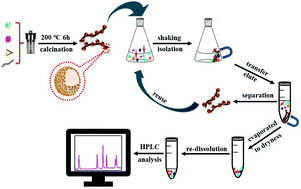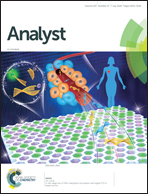A magnetic cellulose-based carbon fiber hybrid as a dispersive solid-phase extraction material for the simultaneous detection of six bisphenol analogs from environmental samples
Abstract
A hollow porous NiMn2O4 nanosphere-decorated cellulose-based carbon fiber (CCF, using recyclable cotton wool as the carbon fiber source) hybrid was fabricated via a relatively green and eco-friendly hydrothermal synthetic route, followed by calcination treatment. The in situ growth of hollow porous NiMn2O4 on the CCFs led to it being decorated over the CCF surface uniformly. The NiMn2O4/CCFs hybrid displayed excellent extraction capabilities and magnetic reusability. Benefiting from its high porosity, large specific surface area, and superior chemical affinities to bisphenol analogs (BPs), and the synergistic effect between NiMn2O4 and CCFs, NiMn2O4/CCFs as an adsorbent was applied to the extraction of low concentrations of BP compounds, displaying excellent extraction capabilities. A magnetic dispersive solid phase extraction (MDSPE) method combined with HPLC was developed for detecting six BPs in real environmental samples. Under optimal conditions, the detection limits and recoveries were 0.56–0.83 ng mL−1 and 84.3–103.5% (RSD ≤ 4.5%). It was confirmed that NiMn2O4/CCFs was a type of rapid and high efficiency MDSPE material for the analysis of multiple BP compounds in environmental samples.



 Please wait while we load your content...
Please wait while we load your content...